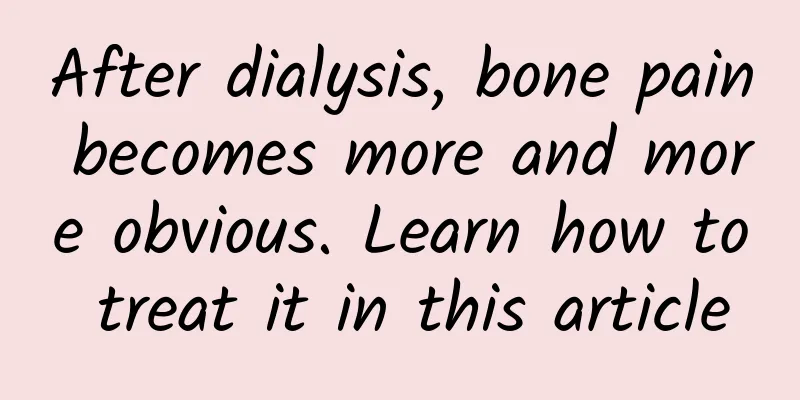After dialysis, bone pain becomes more and more obvious. Learn how to treat it in this article

|
1. Adjusting the dialysis regimen Communicate with your doctor to assess whether the current dialysis is adequate. You may need to increase the frequency of dialysis, extend the dialysis time, or adjust the dialysate composition. For example, adjust the calcium and phosphorus concentrations. The appropriate dialysate calcium ion concentration helps maintain calcium balance in the body and reduce bone pain caused by calcium metabolism disorders. 2. Control calcium and phosphorus levels 1. Limit the intake of phosphorus in the diet and avoid eating high-phosphorus foods, such as animal offal, nuts, etc. At the same time, use phosphorus binders reasonably according to the doctor's advice and take them at the same time as meals to effectively reduce the intestinal absorption of phosphorus. 2. For abnormal blood calcium, adjust the use of calcium supplements under the guidance of a doctor. If blood calcium is too high, reduce the use of calcium-phosphorus binders; if blood calcium is too low, supplement calcium appropriately, but be careful to avoid vascular calcification. 3. Application of Active Vitamin D Detect the level of vitamin D in the body and use active vitamin D and its analogs according to the situation. It can promote intestinal absorption of calcium, regulate the secretion of parathyroid hormone, and help improve bone metabolism. However, it is necessary to pay attention to monitoring blood calcium, blood phosphorus and parathyroid hormone to prevent adverse reactions. 4. Treatment of hyperparathyroidism If the bone pain is caused by hyperparathyroidism, drug treatment can be selected according to the condition, such as calcimimetics, which inhibit the secretion of parathyroid hormone. For severe parathyroid hyperplasia or adenoma, surgical treatment may need to be considered. V. Rehabilitation and auxiliary treatment Appropriate gentle exercise, such as joint range of motion training and low-intensity aerobic exercise, can help improve bone blood circulation and muscle strength and relieve bone pain. At the same time, auxiliary methods such as hot compresses and massage can be used to relieve local pain symptoms. However, when performing these operations, care should be taken to avoid damaging fragile bones. |
<<: Those who have kidney disease and can live to 80 years old basically do these things
>>: Not all dairy products are suitable for kidney patients, especially these ones!
Recommend
A woman's feet reveal her inner consciousness
Introduction: I once chatted with a male friend a...
How can we prevent frequent "strokes" caused by sudden drops in temperature?
The temperature in Tianjin has dropped sharply in...
Two lines are detected seven days before menstruation
Testing for pregnancy is the most concerned issue...
Why do I feel tired when my period is coming?
In real life, women are prone to drowsiness and e...
Buying the wrong contact lenses can damage your cornea! Many people don't know these indicators that you must look at.
Nowadays, many people choose to wear contact lens...
Women have it, men may have it, and pregnant mothers definitely have it! What exactly is this line?
Audit expert: Wang Linyu Deputy Chief Physician, ...
What are the signs of miscarriage in six months of pregnancy?
Six months of pregnancy is the middle stage of pr...
Woman sweating while sleeping
When a person is in a high temperature environmen...
How to check female fertility?
As the recognition of women in all walks of life ...
How long after childbirth is it good to do pelvic floor exercises?
As the saying goes, nine out of ten men have hemo...
Will women become tight if they don't have sex for a long time?
Everyone knows that after having sex many times o...
Kingsley Andovit tablets instructions
One tablet of Kingsley An Multivitamin contains: ...
What are the treatments for uterine polyps?
Endometrial polyps are benign lesions that will n...
Recently, a large number of them have been put on the market. Some people have been hospitalized after eating them! Doctors warn →
Every autumn and winter Selling on the street Swe...
What are the symptoms of true uterine contractions?
We all know that if a pregnant woman has patholog...









